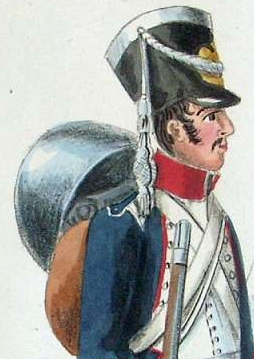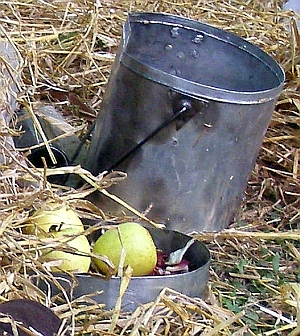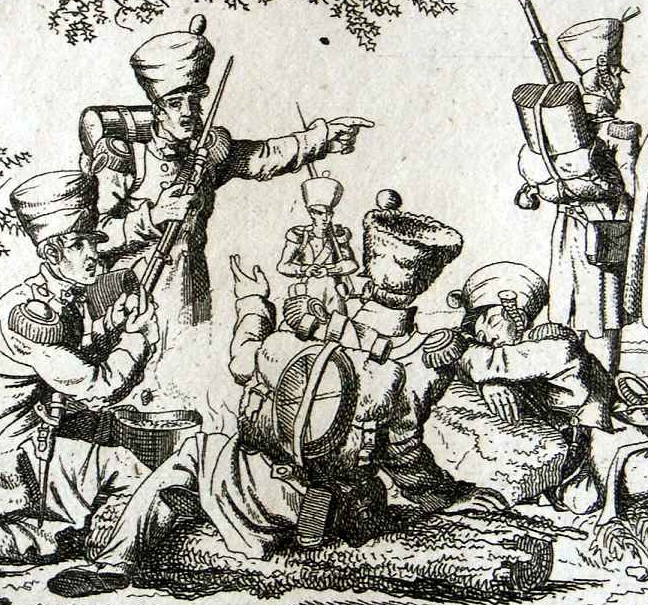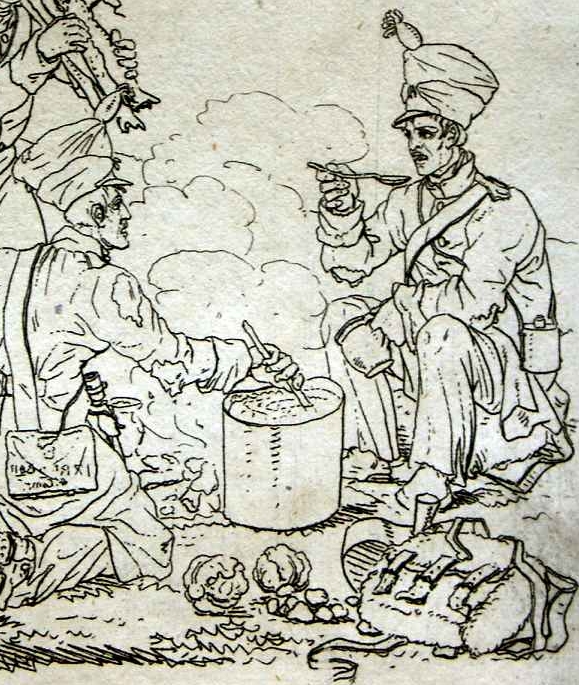|
|
|
|
| auf Deutsch | en français | po polsku |

|
|
A field cauldron on plate 84 ("Soldats du 17e regt de ligne") of the series by the brothers Suhr. |
The "Règlement sur le service de campagne, du 5 avril 1792." (Regulation for the field service, of 5th april 1792.) specified (Tit. 1):
An "Instruction du ministre de la guerre, donnée en brumaire an 12" (Instruction by the Minister of War, given in Brumaire year 12 [24th october to 22nd november 1803]), concerning the organisation of a batallion camp, ordered the following:
I couldn't find any information on the dimensions of field cauldrons before 1807. Perhaps, there was no particular pattern prescribed.
It seems, any cauldrons which were at hand were taken, if they were big enough to cook in them for sixteen men. For example, just before the 1806 campaign, on 15 September 1806, Marshal Davout, commander of the 3rd corps, wrote from Paris to general Friant, who was commanding one of the divisions in his corps:
An example of a cauldron which was in use in 1807 or 1808 can be seen on the illustration at the right. In 1806, the 17e regiment de ligne had been part of Davout's 3rd corps.
The dimensions of a field cauldron were put together in a work which was destined for the Royal Italian army, and printed in 1809: "Descrizione delle dimensioni degli effetti di vestito, fornimento, bardatura, piccolo equipaggio ecc., rilevate sui campioni stabiliti in virtù del § 5.º, articolo 15 del regolamento 1.º Luglio 1807" (Description of the dimensions of the items of clothing, of equipment, of harness, of small clothes etc., taken from the patterns which had been produced according to § 5, article 15 of the regulation of 1st July 1807, on the administration and the accountancy of the corps.) As the army of the Kingdom of Italy was established along the same lines as the French army, and as there are no other sources available, a reconstruction can be based on this text (p. 80 f.):

|
| A reconstructed field cauldron of the Italian pattern. |
The field cauldron with hinges, made of sheeting [latta], 8 pollici 3 linee [22,341 cm] deep. At the back 7 pollici [18,956 cm] in a straight line, at the front it is semi-oval. From one side to the other 11 pollici 6 linee [31,142 cm]. From the back to the front 8 pollici 3 linee [22,341 cm]. At a distance of 6 linee [1,354 cm] from the upper edge, where the top is placed, there is a bead [cordoncino] which is running all around, and which is formed by an iron wire [filo di ferro] of 1 linea [0,226 cm] diameter, covered with a soldered sheeting.
The top [coperchio], made of sheeting, 2 pollici 3 linee [6,093 cm] high.
The ears [occhi], with which the two ends of the handle unite, are each fixed with three rivets [chiodi], which are beaten [ribattuti] from the outside and from the inside: this rivetted plate [piastra inchiodata] of sheeting is 2 pollici [5,416 cm] long and 2/3 linee [0,15 cm] thick. At its upper edge it is 2 pollici [5,416 cm] wide, at the bottom it is peaked. The small bulge [tondino] which forms the ear, made of sheeting, 7 linee [1,579 cm] wide and 2 linee [0,451 cm] thick.
The handle [manico] of the field chaudron, round, made of iron, 26 pollici [70,408 cm] long and 2 linee [0,451 cm] thick. Its length must be that of the bead, measured all around, including the handles [prese] (in the ears) on both ends.
The handle of the top of iron, 6 pollici [16,248 cm] long, 1 pollice [2,708 cm] wide, 1 linea [0,226 cm] thick.Probably in 1815 or shortly afterwards, in Dresden and Pirna a small collection of prints was published, with the title: "Kriegsscenen aus den Jahren 1813 bis 1815, zur Erinnerung für ehemalige Krieger und zum Nachzeichnen und Illuminiren für kleine Leute, in 12 herrlichen Skizzen von Leopold Beyer." (War scenes from the years 1813 to 1815, for the memory of former warriors and for copying and colouring by little people, in 12 splendid sketches by Leopold Beyer.) The complete series can be found on the site of Napoleon-Online.
On two of these sketches, field cauldrons with kidney-shaped cross-sections are depicted. They are higher, but narrower than the Italian model of 1807. They don't seem to have a handle, but this could be an omission by the artist. The top also lacks a handle, but has got a detachable handhold instead.
The advantage of the kidney-shaped cross-section is that when carried on top of the knapsack, the cauldron does not touch the head or shako of its bearer.

|
|
On the left a cauldron near the fire. The soldier in the right background demonstrates how to carry the cauldron on top of the knapsack. It seems there is no bag for putting the cauldron inside. |

|
|
Here it is clearly visible that the cauldron is simply placed near the fire, without any construction to let it hang above. The top of the cauldron, with a detachable handhold, rests against the knapsack in the foreground. |
In Paris in 1813, was published the 4th edition of the "Manuel d'Infanterie ou Résumé de tous les Règlemens, Décrets, Usages, Renseignemens, propres à cette Arme. Ouvrage renfermant tout ce que doivent savoir les sous-officiers." (Manual of infantry or summary of all regulations, decrees, usages and hints useful for this arm. A work which contains everything that the NCOs have to know.) Its author was Etienne-Alexandre Bardin (1774-1841). A kind of 5th edition came out in 1814, with the title: "Cours d'Instruction à l'usage des élèves sous-officiers d'infanterie appelés à l'école de Fontainebleau, Définitivement arrêté par la Commission formée dans la Garde impériale pour cette rédaction." (Course of instruction for the pupils NCOs of infantry called to the school of Fontainebleau, and definitely fixed by the commission formed by the Imperial Guard for its redaction.)
Both editions give the identical description (1813: p. 42, nº53. 1814: p. 244 f.):
This corresponds with the plate by the brothers Suhr represented above, only the linen case is missing.
On the other hand, Beyer (see the image above) shows a field cauldron carried on top of the knapsack. This method has got the advantage not to constrain the man directly behind the bearer of the cauldron.
I wish to express my thanks to Gabriele Mendella and Markus Stein for providing me with primary sources, as well as to Marc Middleton and Steve Kontos.